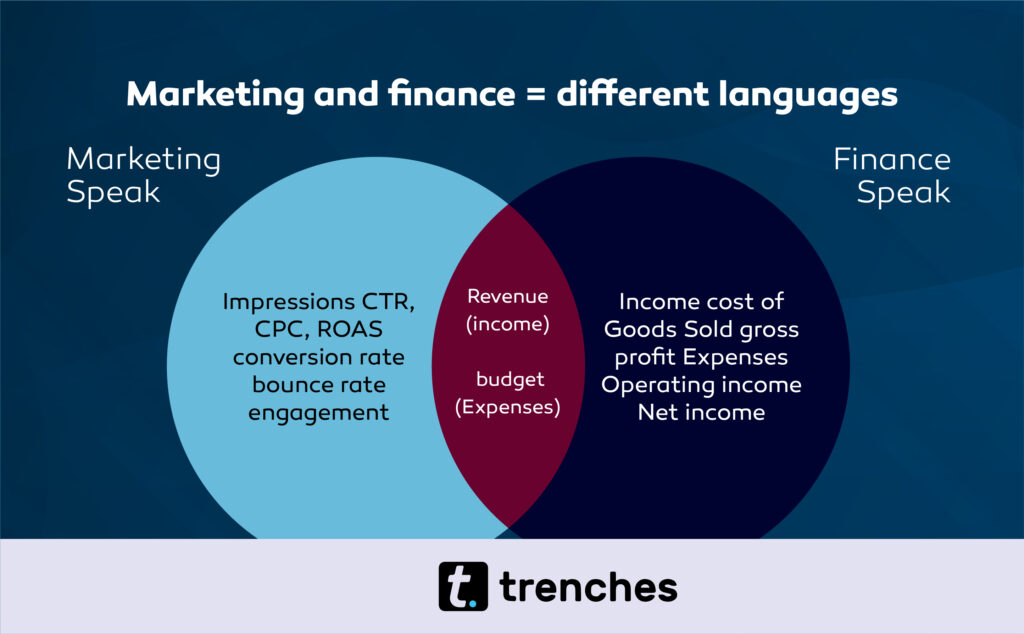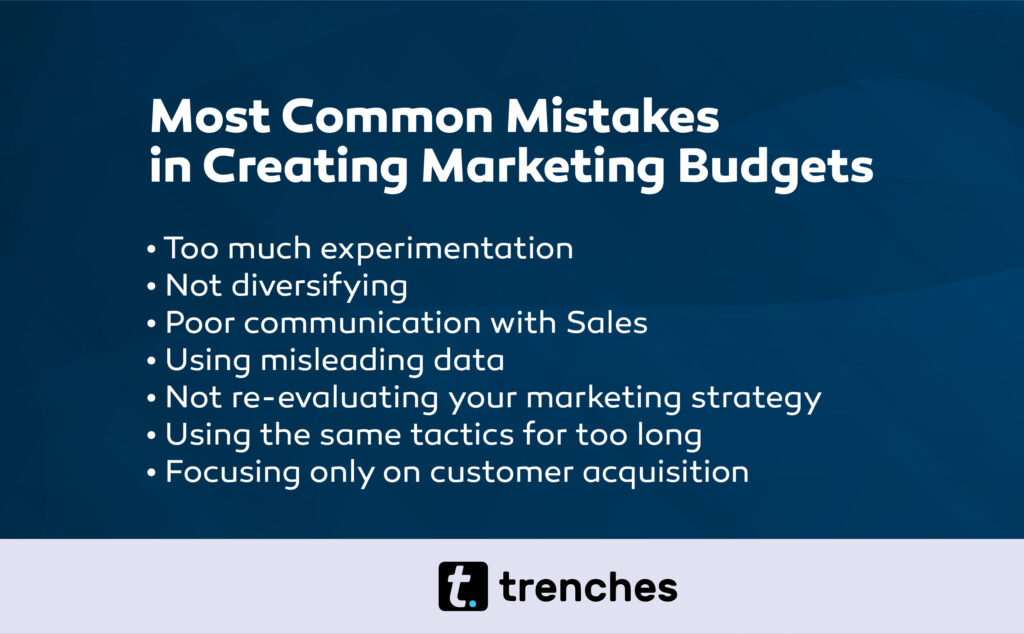In this article, we’ll share some strategies on how to pitch your marketing budget to your CFO and get the funding you need to achieve your marketing goals. But not only that, we’ll also show you how to build a good relationship with your financial department.
Specifically, we’ll be covering:
- How to present and justify marketing investments?
- The reports and numbers CFOs are looking for
- How to improve marketing & CFO relationship?
Let’s kick it off!
Quick overview of marketing budget: bull market vs bear market
If you ask most companies today if they have the budget to invest in their team’s skills, they would probably reply “no”. Actually, lots of B2B companies are dealing with a recession, and marketing budgets are slashed.
The reality is that in a bull market, companies raised money and everybody was focused on growth. So, when marketers used to go to their CFO and say things like: “I need a budget for this specific program or software because I want to accelerate revenue”, they could get that money pretty easily without a solid justification and plenty questions coming from the CFO or key stakeholders.

Generally, no one would even ask how often they would use the software and whether it would benefit all team members.
But nowadays, we are in a bear market. Things have changed. Every cent invested in marketing is questioned and thoroughly reviewed. You need to justify whenever you want to:
- Launch a new program (blending ABM and demand gen for instance);
- Build a new motion;
- Purchase a new product.
Why?
Because in a bull market, stock prices gain value and companies’ revenue increases significantly. While in a bear market, the stock market starts shrinking, leading to economic recession.

And this might be of great help to many companies that have limited resources. They want to see and explain the return on investment for every penny that is invested.
So, looking at the current situation of recession, how should a B2B marketing team present and justify their marketing investments to a CFO? Let’s dive in!
How to present and justify marketing investments?
“One of the biggest mistakes companies make is purchasing software before creating processes”.
Andrei Zinkevich
Amber Bogie from Reachdesk echoed this by saying that the first standard approach is putting together a business case for what you need and why you need it. But prior to that, having a solid relationship with your finance department is a must. Thus, before you even tend to have a conversation with your CFO, you need to:
- Understand why the finance department exists;
- Understand their goals; and
- Be ready to show the KPIs you’ve been working on.
By doing so, your CFO will already know what you’ve been struggling with and what your strategy is. So offhand he/she will already know what your request is supporting. Because at the end of the day, both marketing and CFOs are working towards the same goals.
What is the right way to justify your investments?
As we’ve briefly mentioned, you need to describe and explain what your strategy is as a marketer. That said, you specifically have to:
- Outline your strategy
- Gather the operational tools you need
- Decipher what part of your strategy has a risk
- Show the impacts you are going to see from an investment: especially how this cost is going to help you achieve the goals of your company, and help you close more deals—or not in case you do not implement it.
You also need to have a clear outline of the qualitative and quantitative benefits of the product, software, or vendor you want to bring in. Presenting all these features in an effective way will definitely be valuable to get a consensus with your CFO.
To sum up, if you want to :
1) Purchase new software
- Ask for a trial;
- Run a pilot campaign or create a process/automate your existing process;
- Document it;
- Show positive signals;
- Connect outcomes to revenue.
E.g. Sales enablement software helped to identify engagement from the target account. Sales sent timely follow-ups and booked a meeting with a target decision-maker and champion.
2) Run a new marketing program:
- Start on a shoestring budget and track positive signals—depending on how you build your account development playbook, show that you are connected to people on Twitter or LinkedIn through ABM;
- Document it;
- Compare to other programs and explain what goals it helps to achieve or what challenges it solves;
- Make a forecast demonstrating the impact on sales pipeline velocity or revenue.
3) Bring an agency:
- Ask the agency to dive deeply into your business and come up with a personalized program, not a standard offer;
- Document the responsibilities of an agency;
- Make a forecast with the agency demonstrating the impact on sales pipeline velocity or revenue;
- Compare agency costs to the salaries of in-house marketers.
To give you a better understanding of this, let’s dive into the statistics CFOs are looking for in your marketing reports.
The reports and numbers CFOs are looking for
There are numbers and reports CFOs are dying to see. Here again, if you do not build a relationship with your CFO—on a demand generation basis—he/she will be willing to know:
- The type of pipeline leads opportunities and close rate you have generated;
- What’s the spend and the return on a spend—every cost should be tied to revenue;
- What’s your cost per opportunity—along with opportunity creation;
- Tiers segmentation.
However, this goes a little bit deeper depending on your company and based on the relationship of your teams.
“Operating a global business in a fast-changing world, you have to be grounded real-time in the external environment, have complete transparency, be fact-based, and working with a great, collaborative team”. Bob Shanks, CFO at Ford.
That being said, you can build out models so as to create suitable targets, know the cost per opportunity and per channel, and also, how each channel is performing to leverage your strategy.
So, it’s all about how you are performing from an inbound marketing channel to a close rate. You may bring more (or fewer) opportunities than you set for this specific quarter—and that’s definitely going to change your actual need for the quarter.
Quick example
If you set your goal for quarter X, along with the idea of bringing Y as the conversion rate, but at the end of the day the inbound closure is higher than expected, that’s going to change the whole process.
Thus, on a weekly/monthly basis, you should look for:
- What’s your ROI from a marketing perspective: here you have to set a realistic ROI goal;
- What’s your cost per opportunity;
- How does every channel perform?
As a quick summary, you just have to keep measuring, tracking, and paying attention to the flip rates of meetings to opportunities. In other words, you should keep track of every single cost.
How to improve marketing and CFO relationship?
In most cases, all of these strategies and processes mentioned above will require you to spend more time with your CFO, even though this might be a little bit intimidating at first.
“Unlike what the marketing team would think, CFOs are not the man behind the cart. They’re not that big and scary.”
Amber Bogie
Ironically that goes both ways; CFOs are also intimidated by the marketing team and vice versa.
But see, just because you do different things doesn’t mean you can’t get along. Both marketing and financial departments share the same interests and goals. CFOs are not just “budget gatekeepers”. Rather, you need to understand that CFOs are hired for a specific job and one of their tasks is to make sure that the cash flow is positive.

It’s not all about how to request a budget from your CFO; the first thing that should come forward is that you need to work closer to each other. So first and foremost, if you want to obtain an investment from your CFO, you need to invest in the relationship with him.
Here are the four basic ways you can build a stronger working relationship with your CFO:
- Get regular face time with them—which means that you should meet them regularly, not just when you have meetings;
- Prepare an agenda—every conversation shall be a way to collaborate;
- Match their communication style by using financial language—get rid of marketing jargon!
- Get to know their ins and outs.
As an example from an experience at Fullfunnel.io, if you do not understand the hurdles CFOs are facing, you’ll definitely not be prepared to answer hard questions from them.
Result? They are never going to support your ABM motion.
That’s exactly why you need to:
1) Understand your CFO’s job
Getting familiar with the job of your CFO is the core of getting a consensus with him/her. Marketing operates in a different way from other departments and that makes it somehow tough for the finance department to understand marketing.
If they can’t understand what you do, then it’s up to you to understand what they face and provide the right proof that your investment will be fruitful.
2) Get to know their challenges
As we mentioned, you need to understand that CFOs are hired for a specific job and if they don’t fulfill it, they might get fired! They have to ensure that the investment you’re dying for will pay off—as they are responsible for tracking cash flow and analyzing the financial weaknesses and strengths of the company.
3) Try to be in their shoes
If you do not achieve a given set of goals, what would be the impacts on your department and on the company? Your CFO is asking him/herself the same question. The ironic thing is that both finance and marketing departments are heading toward the same goals.
That being said, your success is theirs and vice-versa. However, unless you get to know your CFO’s challenges and goals, you will never reach that level of understanding.
If you find it quite hard to build a good relationship with your CFO, we recommend you check the book written by Dale Carnegie about how to make friends.
Recap’
As for any other ABM strategy, the process of making your CFO say yes to your marketing budget is a long game—nothing works overnight in that industry.
Philip Kotler said it best in his words “It is more important to do what is strategically right than what is immediately profitable”, regardless of the time it will take.
But that’s where most B2B companies get it wrong because they are always looking for instant gratification, and more leads in demand generation—which is absolutely not realistic.

That said, there are two basic things you have to do if you want a good answer from your CFO.
- One is to set up your expectations and how many months/years it will take to build a given product, project, software, etc.
For example, if your sales cycle length is 12 months, the right justification period should be at least half of that period.
- The second most important thing is to run the business and bring results at the same time.
Take it like both things are humming together so that you can’t press pause in any of the processes. You should have a solid program for a specific need—even if you already have a whole bunch of experience in ABM.
“There is a huge learning curve behind.” Andrei Zinkevich
Just because a strategy worked for a given company doesn’t mean it will work for your company too. Companies have different priorities, and that’s exactly why it’s important to build a good relationship with your buying committee—that is the CFO in this case!

